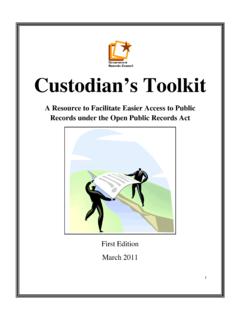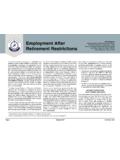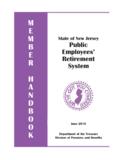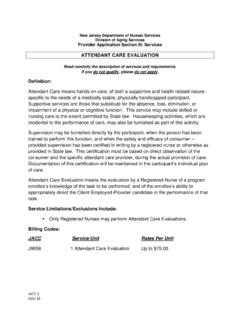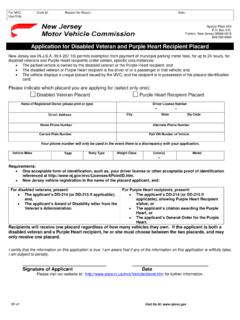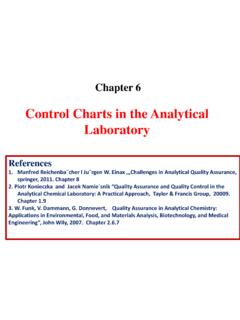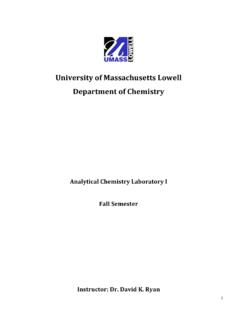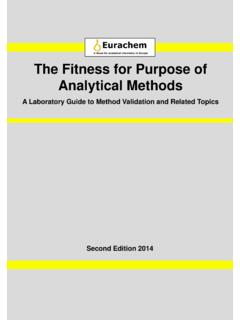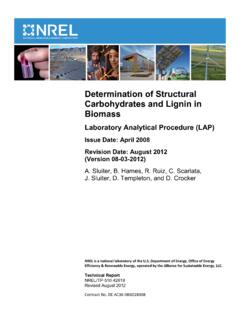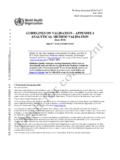Transcription of Laboratory Quality Assurance and Quality Control Data ...
1 New Jersey Department of Environmental Protection Site Remediation Program DATA Quality ASSESSMENT AND. DATA USABILITY EVALUATION. TECHNICAL GUIDANCE. Version April 2014. Preamble The results of analyses performed on environmental matrices are used to determine if remediation is needed. Because of the nature of environmental matrices, limitations of analytical methods, characteristics of analytes, and inherent error associated with any sampling and analysis procedure, the results of environmental analysis may contain an element of uncertainty and in some cases may be significantly biased, and therefore may not be representative of the actual concentrations of the analytes in the environmental matrices. Thus, an evaluation of the Quality of the analytical data in relation to the intended use is important in order for the investigator to make decisions which are supported by data of known and sufficient Quality . There are many ways to evaluate the Quality of analytical data in terms of precision, accuracy, representativeness, comparability, completeness and sensitivity in relation to the intended use of the data.
2 Precision, accuracy, representativeness, comparability, completeness and sensitivity are collectively referred to as the PARCCS parameters. This guidance document describes a NJDEP-accepted, two-step process for data evaluation. The first step in the process consists of an assessment of data Quality . The second step is an evaluation to determine whether the data can be used to support the decisions that will be made using that data. Use of this guidance provides consistency in evaluation and presentation of data Quality information that will facilitate review. If an alternative process is used, such a process should be documented in order to explain the thought process and may involve a commitment of significant resources to demonstrate that the data is of known and sufficient Quality and is usable relative to its intended purpose. To assist the investigator in obtaining analytical data of known Quality , the Work Group developed the Data of Known Quality Protocols (DKQPs).
3 The DKQPs include specific Laboratory Quality Assurance and Quality Control (QA/QC) criteria that produce analytical data of known and documented Quality for analytical methods. When Data of Known Quality are achieved for a particular data set, the investigator will have confidence that the Laboratory has followed the DKQPs, has described nonconformances, if any, and the investigator has adequate information to make judgments regarding data Quality . i The Data of Known Quality performance standards are given in Appendix B of the NJDEP Site Remediation Program, Data of Known Quality Protocols Technical Guidance, April 2014. These protocols will enhance the ability of the investigator to readily obtain from the Laboratory the necessary information to identify and document the precision, accuracy and sensitivity of data. ii Preamble .. i 1. Intended Use of Guidance Document .. 1. 2. Purpose .. 2. 3. Document Overview .. 5. 4. Procedures .. 6. Figure 1: DQA and DUE Flow 7.
4 Data Quality Objectives .. 8. Uncertainty in analytical Data .. 9. Types of analytical Data .. 9. PARCCs Parameters .. 10. Precision .. 10. Accuracy .. 11. Representativeness .. 12. 12. Completeness .. 13. Sensitivity .. 13. Data Quality Assessment .. 14. Batch Quality Control versus Site Specific Quality Control .. 15. Evaluating Significant Quality Control Variances .. 16. Poorly Performing 16. iii Common Laboratory Contaminants .. 17. Bias .. 17. Data Usability Evaluation .. 17. Evaluation of Bias .. 20. General Quality Control Information .. 23. Chain of Custody Forms .. 23. Sample Preservation Holding Times and Handling Time .. 23. Equipment, Trip and Field Blanks .. 26. Field Duplicates .. 28. Laboratory Quality Control Information .. 30. Data of Known Quality Conformance/Nonconformance Summary Questionnaire .. 31. Reporting 31. Method Blanks .. 33. Laboratory 34. Surrogates .. 34. Laboratory Control Samples (LCS).. 37. Matrix Spike/Matrix Spike Duplicates and Matrix Spike/Matrix Duplicate 38.
5 Internal Standards .. 41. Serial Dilutions (ICP and ICP/MS) .. 42. Interference Check Solution .. 42. Matrix Spikes and Duplicates .. 44. Internal Standards for ICP/MS (for Metals) .. 45. Using Multiple Lines of Evidence to Evaluate Laboratory QC Information . 45. Data Usability Evaluations for Non-DKQ analytical 47. Data Usability Evaluations Using Multiple Lines of Evidence from DQOs and the CSM .. 49. iv Factors to be Considered During Data Usability Evaluations .. 50. Documentation of Data Quality Assessments and Data Usability Evaluations .. 52. REFERENCES .. 54. Appendix A Supplemental Information on Data Quality Objectives and Quality Assurance Project Plans .. 56. Appendix B QC Information Summary and Measurement Performance Criteria .. 58. Appendix C QC Information to be Reviewed During Data Quality Assessments .. 66. Appendix D Data Quality Assessment Worksheets and Summary of DKQ. Acceptance Criteria .. 71. Appendix E Evaluating Significant QA/QC Variances.
6 85. Appendix F Poorly Performing Compounds .. 92. Appendix G Range of Data Usability Evaluation Outcomes .. 95. Appendix G Range of Data Usability Evaluation Outcomes .. 96. Appendix H Data Usability Evaluation Worksheet .. 105. Appendix I Surrogates and Internal 109. Appendix J Supplemental Examples Using Multiple Lines of Evidence .. 113. Appendix K: Glossary .. 119. Appendix L: List of Acronyms .. 130. v 1. Intended Use of Guidance Document This guidance is designed to help the person responsible for conducting remediation to comply with the Department's requirements established by the Technical Requirements for Site Remediation (Technical Rules), 7:26E. Because this guidance will be used by many different people that are involved in the remediation of a contaminated site such as Licensed Site Remediation Professionals (LSRPs), Non-LSRP environmental consultants and other environmental professionals, the generic term investigator will be used to refer to any person that uses this guidance to remediate a contaminated site on behalf of a remediating party, including the remediating party itself.
7 The procedures for a person to vary from the technical requirements in regulation are outlined in the Technical Rules at 7 Variances from a technical requirement or guidance must be documented and be adequately supported with data or other information. In applying technical guidance, the Department recognizes that professional judgment may result in a range of interpretations on the application of the guidance to site conditions. This guidance supersedes previous Department guidance issued on this topic. Technical guidance may be used immediately upon issuance. However, the NJDEP recognizes the challenge of using newly issued technical guidance when a remediation affected by the guidance may have already been conducted or is currently in progress. To provide for the reasonable implementation of new technical guidance, the NJDEP will allow a 6-month phase- in period between the date the technical guidance is issued final (or the revision date) and the time it should be used.
8 This guidance was prepared with stakeholder input. The following people were on the committee who prepared this document: Greg Toffoli, Chair (Department), Office of Data Quality Nancy Rothman, , New Environmental Horizons, Inc. Rodger Ferguson, CHMM LSRP, Pennjersey Environmental Consulting Stuart Nagourney (Department), Office of Quality Assurance David Robinson, LSRP, Synergy Environmental, Inc. Joseph Sanguiliano (Department), Office of Data Quality Phillip Worby, Accutest Laboratories, Inc. 1. 2. Purpose The purpose of this document is to provide guidance on how to review and subsequently use analytical data generated pursuant to the remediation of a discharge of a contaminant(s). Laboratory Quality Assurance and Quality Control (QA/QC) is a comprehensive program used to enhance and document the Quality of analytical data. QA involves planning, implementation, assessment, reporting, and Quality improvement to establish the reliability of Laboratory data.
9 QC procedures are the specific tools that are used to achieve this reliability. Evaluating the Quality of analytical data to determine whether the data are of sufficient Quality for the intended purpose is a two-step process. The first step of the process is a data Quality assessment (DQA) to identify and summarize any Quality Control problems that occurred during Laboratory analysis (QC nonconformances). The results of the DQA are used to perform the second step, which is a data usability evaluation (DUE) to determine whether or not the Quality of the analytical data is sufficient for the intended purpose. To assist the investigator in obtaining usable, good' analytical data, the NJDEP analytical Technical Guidance Work Group developed the Data of Known Quality Protocols (DKQPs). The DKQPs are a collection of analytical methods that contain specific performance criteria and are based on the conventional analytical methods published by the Environmental Protection Agency (EPA).
10 DKQPs have been developed for the most commonly used analytical methods. DKQPs may be developed for other methods in the future. analytical data generated from the DKQPs are termed Data of Known Quality (DKQ). When the DKQPs are followed the investigator can have confidence that the data are of known and documented Quality . This will enable the investigator to evaluate whether the Quality of the data is usable. (When the performance criteria in the DKQPs are met, it is likely that the data will be usable for project decisions.) Information regarding the DKQPs and Laboratory QA/QC is presented in the NJDEP guidance document titled NJDEP Site Remediation Program, Data of Known Quality Protocols Technical Guidance, April 2014 (DKQ Guidance). The DKQ Guidance and DKQPs are published on the NJDEP web site at: #analytic_methods. 2. The DKQP Guidance includes the Data of Known Quality Conformance/Nonconformance Summary Questionnaire that the investigator may request the Laboratory to use to indicate whether the data meet the guidelines for DKQ.
